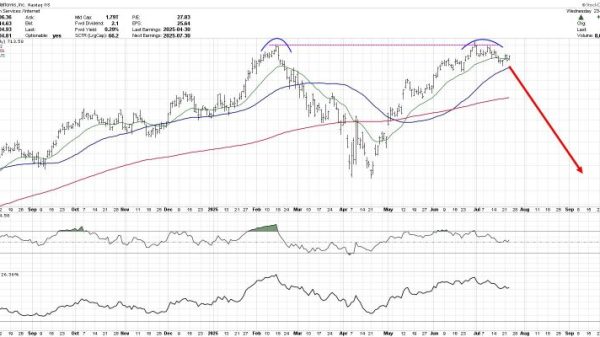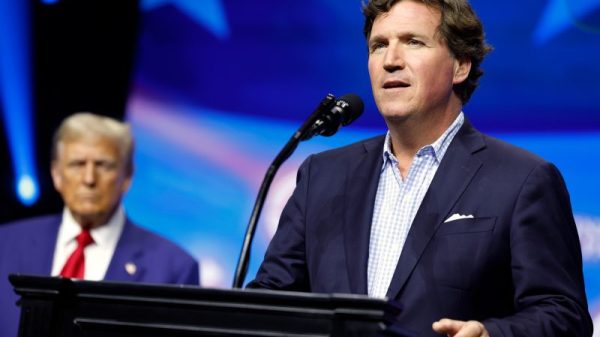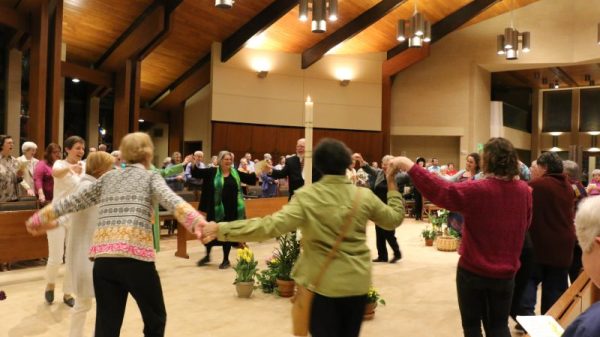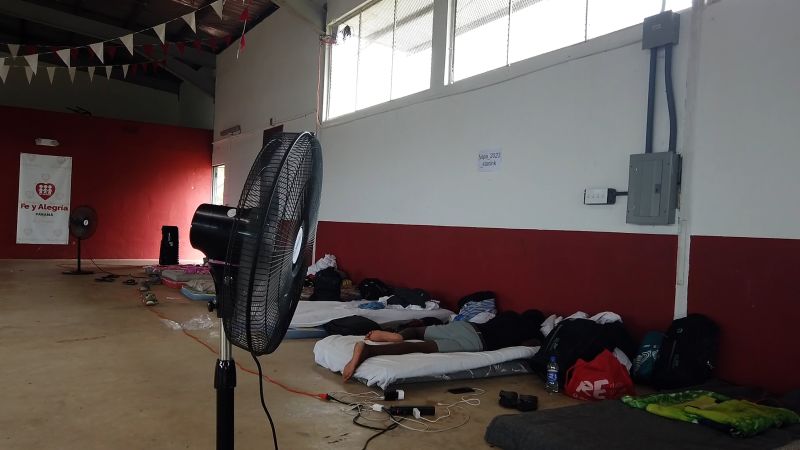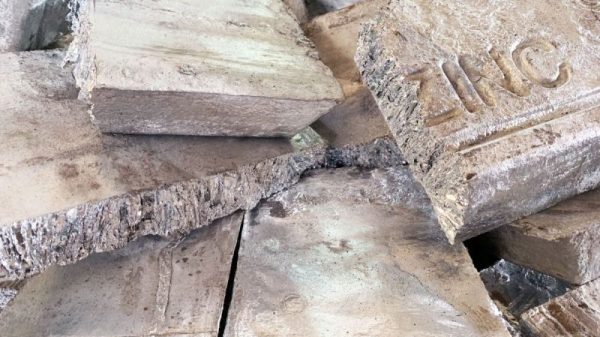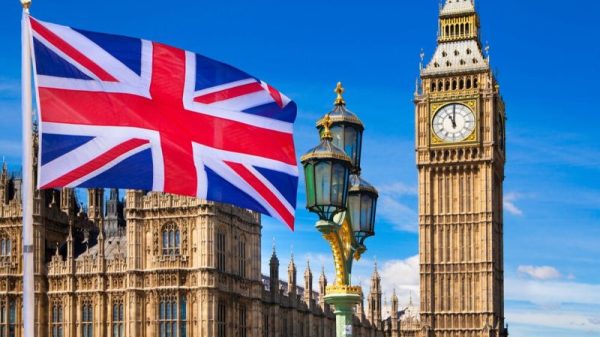She asked to be identified only as “Ambo,” out of fear of being recognized back in her home country.
Over the ambient noise of blade fans attempting to cool the large room, she explained she left her native country of Cameroon due to “political issues,” fearing that she would either be “sentenced dead” or spend the rest of her life in prison if she stayed.
She remembers arriving at the US-Mexico border on January 23 – three days after US President Trump’s inauguration – after trekking through Central America and the dangerous Darién jungle.
She turned herself in to United States Customs and Border Protection in hopes of making her case for asylum. By her count she spent 19 days in US custody, then finally got that chance – or so she thought.
Just after midnight on February 13, by her recollection, she and other migrants were loaded onto a bus where they drove for hours.
“We were so happy thinking that they were going to transfer us to a camp where we are going to meet an immigration officer,” she recalled.
She still thought that when she was loaded onto a plane, believing they were headed to another facility in the United States. But when they landed, they were in Panama.
“We’re asking them why are they bringing us to Panama? ‘Why are we in Panama?’” she said, “People started crying.”
Even still, she was optimistic.
“We’re like thinking maybe the camp in the US is full. That is why they are bringing us here. When it will be our turn, they will come and take us to give us a listening ear,” she said.
Even in a new country, under a new government authority, she held out hope someone from the United States government would step in and fix the situation.
“It wasn’t the case.” Her voice cracked, recalling the moment her optimism shattered.
‘Everyone is in a bad situation’
This is the downstream reality of an increased immigration crackdown in the United States, which the Trump administration has pressured Latin American countries like Panama, Costa Rica, and El Salvador to help with.
Just days before she arrived at the border, Trump had signed an executive order effectively shutting down the US-Mexico border to migrants seeking asylum in the United States. Weeks later, the Panamanian government agreed to receive some of those migrants, at least temporarily, and took in nearly 300.
Many are asylum-seekers from places like Iran, Afghanistan, Russia, China, Sri Lanka. They are now are caught in limbo – expelled from the United States, but unable to go back to their home countries out of fear of being persecuted or killed.
“They shouldn’t just like abandon us like that without telling us what we have done wrong. It become very, very difficult and confusing to us. I’ve left my children back home,” Ambo said through tears.
Another woman from Ethiopia, was on a similar flight. She too requested not to use her name for fear of retaliation in her home country.
“I am so shocked. I’m saying this is Texas or Panama?” she recalled.
They all now live in a humble shelter, one of multiple places in Panama where these migrants are trying to navigate life, in a country where they don’t speak the language.
“Almost all of us are from different countries, but here we are like family, you know?” said the woman from Ethiopia.
“Are you going to kill us?”
Days after they were initially brought to a Panamanian hotel, the migrants were loaded onto buses again. They expected to be moved to another hotel, Ambo says.
But the drive stretched on for hours, until they arrived at a facility over a hundred miles outside of Panama City on the outskirts of the Darién jungle near the border with Colombia.
“Are you going to kill us? Why are you bringing us here?” she recalled asking in fear, “Bringing us in this place, a forest. What is going to happen to us?”
Artemis Ghasemzadeh, an English teacher from Iran, remembers crying after being expelled from the United States on her February birthday.
In February she was seen in a window of the migrant hotel with the words “Help Us” written across the window.
Days later she was at this Panamanian jungle camp, known as the San Vicente shelter, with over 100 other migrants who were in the same situation as hers.
“The food was really disgusting,” said Ghasemzadeh. “The bathroom was really dirty, no privacy, no door,” she added.
Salam said the water for bathing was not clean, causing hives to break out on her skin. She pulled up a pant leg to show the marks on her skin. “All my body is like this,” she said.
Panama’s President José Raúl Mulino has repeatedly denied that authorities have violated the deportees’ rights. Reached for comment about conditions at the camp, a spokesperson from the Panamanian Security Minister’s office deferred to the International Office for Migration (IOM), which assists migrants.
Through every step of the way, attorneys for these migrants argue their rights were violated.
“Our claim is that America violated the right to seek asylum and by extension, by receiving them, the Panamanian government did the same thing,” said Silvia Serna Román, regional litigator for Mexico and Central America for the Global Strategic Litigation Council. “Even though they all claim to be to be asylum seekers, they have never had their right to be heard,” she added.
Serna Román is part of a group of international lawyers that filed a lawsuit against Panama on these alleged violations in the Inter-American Commission on Human Rights. Ian Kysel, who is also part of that group, has previously said they are exploring a range of further legal actions, including against US-specific entities and other countries that might be taking in deported or expelled US migrants.
Panama has denied any wrongdoing in this saga.
In early March, the Panamanian government released the over 100 migrants from the remote jungle camp, but gave them 30-day “humanitarian” permits, extendable up to 90 days, to find another place to go or risk deportation from Panama.
“We’re also trying to navigate the terms of those permits,” Serna Román explained. “If they’re only given 90 days and the 90 days come up then they might be forcibly removed and they might be like involuntarily be taken back to their countries and that’s our concern,” she added.
‘If I come back to my country, my government will kill me’
“Asylum means I’m not safe in my country, I need help. Just that. I’m not criminal. I’m educated person and just need help,” Ghasemzadeh explained.
“If I come back to my country, my government will kill me, so in Panama they are free to kill me,” she added.
Ambo, her life now in a demoralizing standstill, still dreams about the United States, even though she has no idea when this nightmare will end.
“America has always been a country that received people from all over the whole world. I believe that is why many people are going towards the USA for to seek for asylum,” she said.
“They should listen to us and see if they can permit us to stay or not because when you don’t listen to somebody, it means that human rights does not exist again in America.”





